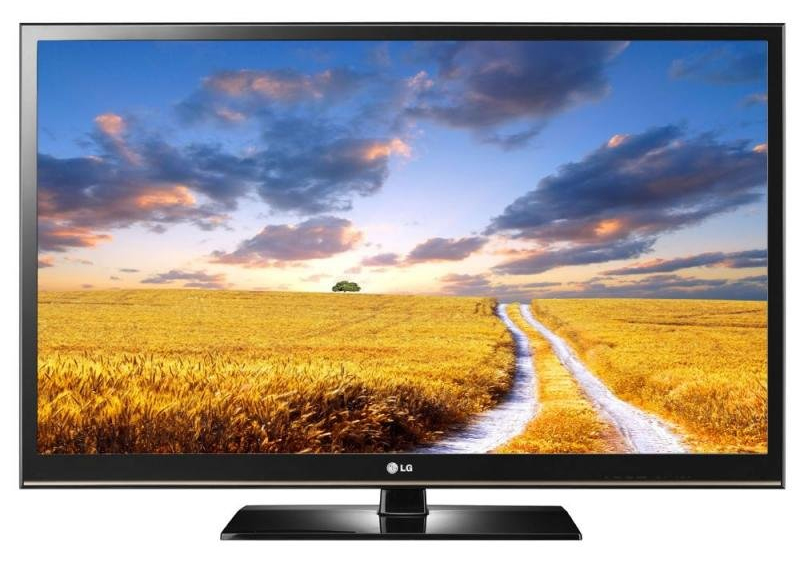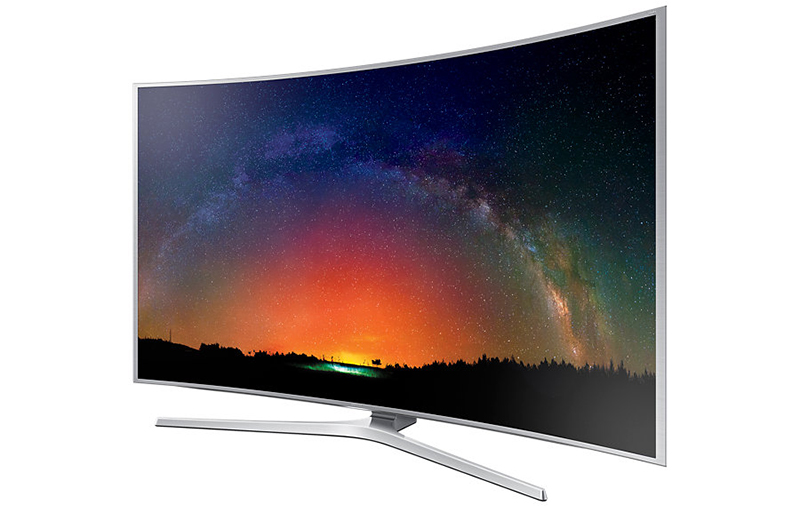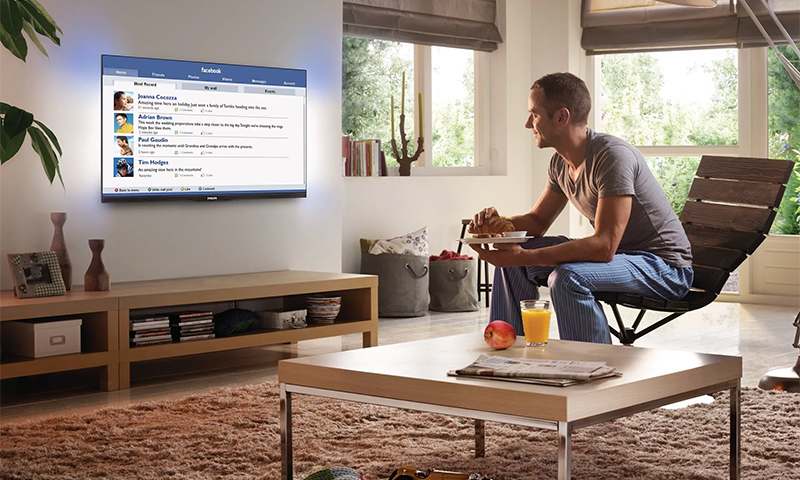The era of tube TVs has already ended, and beautiful flat screens have replaced the round kinescopes. Now manufacturers have a free hand - and they can create monitors of any size (within reason). And we happily meet megadyuymy and do not spare money to buy the most huge TV in the store, completely forgetting that more does not mean better.

Content:
Types of TV screens
Liquid crystal

LCD TVs work by polarizing (sifting) the luminous flux. In LED models, diodes create it; in LCD, fluorescent lamps. But in general, the principle of their work is not too different.
Liquid crystals deposited on the glass of the monitor detain some light waves and let the others through, showing their part of the picture on the screen.
It is necessary to change the characteristics of the electromagnetic field acting on the LCD coating, and now the "screening" is different, and the image on the TV changes.
This technology allows you to create thin and wide screens - of course, with its advantages and disadvantages.
Pros:
- Low power consumption;
- There is no flicker of the picture, tiring eyes;
- Sufficient brightness of the glow in the range of 170-250 cd / m2;
- Clear image transmission without distortion;
- Large selection of diagonals;
- Affordable cost;
- Long service life.
Minuses:
- As a rule, small viewing angles in the range of 50-125 °;
- No volume and depth of the image;
- Long response time matrix;
- Fixed resolution.
Plasma

They are similar in appearance with LCD units, but have a different image display technology. Here the pixels themselves, formed by cells with gas enclosed in them, are already glowing. When voltage is applied, the internal gas environment is ionized, accompanied by luminescence - as in fluorescent fluorescent lamps.
Pros:
- Large viewing angles without loss of picture quality;
- Juicy and very realistic images with high contrast;
- High flicker frequency (about 600 Hz), which the human eye "does not notice";
- Fast response - fast movements on the screen are not blurred.
Minuses:
- Not small, plasma is always a large format;
- The high cost and power consumption, because of what these TVs are gradually being squeezed out of the market;
- Less service life than LCD due to burnout of the phosphor;
- Too large pixels that do not allow you to comfortably watch TV at close range.
OLED screens

At the heart of such TVs is a matrix with organic diodes. When an electric pulse is transmitted, they themselves begin to glow, and the phosphor deposited on the surface of the crystal colors the beam of light in red, green or blue.
Such a decision made it possible to make screens of any shape and even create flexible panels (although this is not the case with TVs).
Pros:
- High quality and unreal image brightness (up to 100 thousand Cd / m2);
- Virtually unlimited viewing angles;
- Impeccable contrast and color reproduction;
- Low power consumption;
- No flicker and minimum response time - thousandths of a second;
- Realistic image;
- A large choice of sizes, although large OLED formats are rarely successful.
Minuses:
- Fast burnout of blue phosphor;
- High price;
- Few manufacturers have mastered this technology.
Parameters affecting the choice of diagonal

Distance to screen
This is the first thing to consider when choosing a diagonal (read - size) TV. Agree, it is difficult to see what is happening on a small screen from a distance of 10 m.But to turn his head, standing near plasma at half a wall, is also not an option. Therefore, you need to decide how far the sofa will be in your TV zone.
Experts advise to adhere to the rule: 3-4 diagonal lengths should fit inside the screen to the viewer. But there are other recommendations (however, they are not too contrary to the previous advice):
1. If the distance between the screen and the person does not exceed 1-1.5 m, the optimal diagonal of the TV is 17 ″;
2. At 2 m - 25 ″;
3. 2.5 m - 32 ″;
4. 2.7 m - 37 ″;
5. 3 m - 40 ″;
6. 4 m - 50 ″;
7. 5 m - 63 ″;
8. 6 m - 80 ″.
Resolution
HD (1280x720)
Not the most recent, but quite common format. For him, the optimal distance to the screen and the diagonal should be related as 1: 2.3.
For those who are reluctant to do the calculations, we give ready-made numbers:
1. At a distance of 1 m will be quite comfortable to watch a 17-inch HD-TV.
2. At a distance of 2 m - respectively 34 ″.
3. Further on each meter add to the previous figure on 17 ″, until you reach the desired value.
Full hd
At a resolution of 1920 × 1080 pixels, the dependence of the diagonal and the distance to the screen is as follows:
1. 1 m - 25 ″;
2. 2 m - 50 ″;
3. 3 m - 75 ″.
Here, the calculation uses the coefficient of 1.56.
Ultra HD (4K)
Gives even better picture quality with a resolution of 3840x2160 pixels, which means you can afford a cool panel with the largest diagonal:
1. At a distance of 1 m - 39 ″;
2. 2 m - 78 ″;
3. 3 m - 117 ″ (although it is unlikely you will find such a huge panel on the free market).
Room features
The TV should harmoniously fit into the interior, without being lost against the general background, but also not blocking the walls in a small room.
In the store, it is very difficult to estimate the dimensions of the selected panel correctly - here you can only compare it with screens from other manufacturers. Therefore, it is better to simply clarify the width and height of your favorite TV, and at home, move the dimensions to the wall and estimate how successful this solution will be.
You can also focus on the area of the room, though very approximately:
1. In small rooms, small screens up to 20 inches will look good.
2. On an area of up to 18 m2 it is better to put a TV with a diagonal not exceeding 37 ″.
3. From 40 inches go panels for very spacious rooms (20 squares and more).
What TV diagonal to choose

1. For a small kitchen, you can choose an LCD TV with a diagonal of 17-20 inches and HD resolution. Such a unit will easily fit over the kitchen table or in the opening between the cabinets.
2. In the bedroom or spacious living room of 20 m2, choose a diagonal of 40-42 inches. If the resolution is high enough (for example, FHD), you can increase the panel size to 75 ″. As a rule, in these rooms the distance from the viewer to the screen does not exceed 3 m.
3. If you have enough funds and square meters, feel free to buy a large-size Ultra HD TV the largest size. With high image quality, you will quickly get used to any giant, even if it occupies the entire wall.
How much are the TVs of different diagonal

1. A small TV with a diagonal of up to 20 inches can be purchased at prices ranging from 5,800 rubles to 70,000.
2. For the model size of 30-40 ″ will have to pay from 10 to 227 thousand rubles.
3. The cost of 50-inch panels is slightly higher (22-250 thousand).
4. A big screen from 60 to 70 ″ will draw at least 156 thousand rubles, the ceiling for such models is 1.6 million.
5. For a 100-inch megapanel, you will have to pay about 4.5 million rubles.
It will be interesting to friends too









